As most of my readers know, I enjoy fishing in both fresh and salt water and appreciate the beauties and charms of both. What many do not know is that most of my flies are designed to be fished (with small modifications) in both fresh and salt water and for many different species). Take for example one of my favorite flies for fall fishing — the Hoverbugger.
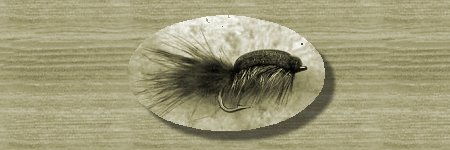
The Hoverbugger (in the version presented here) is designed mainly for fishing for trout and smallmouth bass, both of which fish take it eagerly throughout much of the year but especially so in the fall. With a few modifications it may also be tied to catch tarpon, snook, jacks, or even bonefish (see my book Scratching the Surface). As a "bug," this fly doesn't imitate anything in particular but simply looks like something good to eat—and eat it fish do.
The Hoverbugger may be tied large — up to #2 — or small (down to #18), in various colors to suit your mood or that of the fish. My favorite sizes for trout and bass are #8 and #14 tied in black or gray.
The fly may be fished in many different ways (always the signature of a good fly). You can dead-drift it or swing it. Fish it on the surface either quietly or with occasional twitches. You can pull it under the surface and fish it in the surface film (my favorite way to fish it) and then either give it motion or none as the situation demands. Fish it on a river or on a lake or pond, for trout or bass or any other species that will take a surface bug. Be adventurous and try it next time you go salmon fishing; you may be pleasantly surprised.
One more variation of the Hoverbugger is especially useful: the Gurgler. To create a Gurgler simply leave a lip on the fly rather than cutting your foam down close to the eye (read more about Gurglers in Tying the Gartside Gurgler). Mini-Gurglers, by the way, can be deadly on trout. Give them a try sometime.
Tying the Hoverbugger
|
Hook: |
MM3406 or equivalent, Sizes 8 - 2. Other hook styles for smaller sizes (10-18) |
|
Thread: |
Danville's 3/0 black, brown, or white depending on body color |
|
Tail: |
Marabou (I prefer short chicken marabou for most sizes) |
|
Body: |
White closed-cell foam, with five evenly-spaced segments. (thickness may vary depending on effect desired) |
|
Rib: |
Saddle hackle to match body color palmered between segments |
|
Carapace or Shell: |
Closed-cell foam |
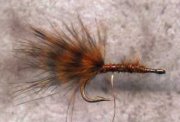 Tie in tail just before bend of hook. Length may vary depending on effect desired.
Tie in tail just before bend of hook. Length may vary depending on effect desired.
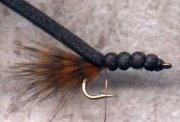 Tie in foam at base of tail and on top of shank so that front part of foam ends just short of eye, leaving around 2"-3" trailing to rear of hook shank. With your tying thread, wind forward and make four or five distinct and relatively evenly-spaced segments of foam (cupping he foam around the hook shank as you wind forward).
Tie in foam at base of tail and on top of shank so that front part of foam ends just short of eye, leaving around 2"-3" trailing to rear of hook shank. With your tying thread, wind forward and make four or five distinct and relatively evenly-spaced segments of foam (cupping he foam around the hook shank as you wind forward).
When you've created all segments and thread is now at the eye of the hook, wind thread back over the body BETWEEN The SEGMENTS, tightening the thread against the foam as you wind (so that you have a tight bond between foam and shank).
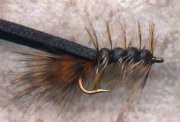 At the rearmost segment of foam, tie in a saddle feather of appropriate width and length (by the tip), trim excess, and wind forward between segments until you've reached a point just behind the eye. I often take an extra turn of hackle at this point to give the fly an extra-"buggy" appearance but this is a matter of taste only. Tie off and trim excess.
At the rearmost segment of foam, tie in a saddle feather of appropriate width and length (by the tip), trim excess, and wind forward between segments until you've reached a point just behind the eye. I often take an extra turn of hackle at this point to give the fly an extra-"buggy" appearance but this is a matter of taste only. Tie off and trim excess.
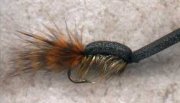 Bring foam over top of body and tie down snugly just behind eye.Whip finish head and trim foam snug to shank (forming a small foam head, really).
Bring foam over top of body and tie down snugly just behind eye.Whip finish head and trim foam snug to shank (forming a small foam head, really).






